If you do
NOT see the Table of Contents frame to the left of this page, then
Click here to open 'USArmyGermany'
frameset |
69th Signal Company (Photo)
Signal Division, European Command
Looking for more information from military/civilian
personnel assigned to or associated with the U.S. Army
in Germany from 1945 to 1989. If you have any
stories or thoughts on the subject, please contact me . .
|
|
|
|
|
|
| 7796
Signal Photo Company |
| |
| (Source: Werner
J. Severin, 7796 Sig Co, 1948-50; Paris and Orleans, France, 1950-52) |
HISTORY OF
THE 7796TH SIGNAL PHOTO COMPANY
The 7796th Signal Photo Company is the present designation of a unit
which has been in existence since October 1944, having been organized
during the war as the 3264th Signal Service Company
(Photo) from personnel of other units then in the European
Command. Its first station was in France and it moved forward with
the advance of the American troops from France into Germany. Shortly
after the cessation of hostilities it was stationed at Wiesbaden where
it remained until 13 December 1946 when it was transferred to Hanau
Signal Depot Sub-Post, located approximately 2 miles east of Hanau-on-Main
and about 20 miles east of Frankfurt-on-Main. In the early fall of
1947 the designation was changed to 69th Signal
Photo Service Company which remained its title until June
20, 1948, when its designation was again changed and it became 7796th
Signal Photo Company. The strength of the unit has varied
at times from a total of 200 EM and 20 officers to its present authorized
strength of 42 EM and 3 officers.
The 7796th Signal Photo Company staffs and operates the EUCOM Signal
Photo Center and the EUCOM Central Film & Equipment Exchange, the
latter being located at Friedberg approximately 20 miles north of
Frankfurt-on-Main. The EUCOM Signal Photo
Center is charged with furnishing still and motion picture
coverage of all material requested by the Department of the Army,
by Hq. European Command, or by the Chief Signal Officer, and serves
as a point of shipment of photographic material to the United States.
All photographic negatives that have been exposed by Signal troops
throughout the European Command are forwarded to the Department of
the Army where they are maintained at the Office of the Chief Signal
Officer at Washington D. C. To perform these photographic functions,
the 7796th Signal Photo Company has a complement of still and motion
picture photographers, sound recording technicians and laboratory
technicians, all of whom are well trained, having received their training
in civilian life, at a Signal Corps school or by on-the-job training
within the unit itself.
The EUCOM Central Film & Equipment Exchange
is charged with the supervision of all Film & Equipment Exchanges
throughout the European Command. These Film & Equipment Exchanges
perform a film library service which makes it possible for Training
and I&E officers to show training films to the troops which otherwise
would not be available to them, and makes it possible for instruction
to be given not only in a standard manner but with better effect than
by the use of other methods of instruction. The personnel of the EUCOM
Central Film & Equipment Exchange coming from the 7796th Signal Photo
Company have also been trained either in civilian life, in a Signal
Corps school or since their assignment to the Company.
The record of the 7796th Signal Photo Company and its predecessors
has been a distinguished one. Records indicate that three members
of the 3264th Signal Service Company (Photo) lost their lives in the
service of their country during the late war, and the Company considers
it to be a compliment that the baseball field at Hanau Signal Depot,
where the Company is stationed, is named Herold Field after Lt. George
H. Herold, a member of the 3264th Signal Service Company (Photo),
who was killed in action during the latter part of the war.
The personnel of the Company have distinguished themselves on many
occasions by furnishing photographic services of a high caliber, and
it is believed that the records of the organization with respect to
the health and conduct of its members is among the best in this Command.
|

|
|
| |
| (Email: Werner
J. Severin, 7796 Sig Co, 1948-50) |
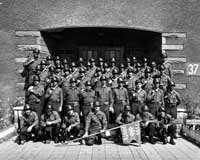
1.
7796 Sig Photo Co, July 1948 (150 KB)
|
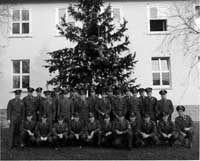
2. Company
photo, Dec 1949 (103 KB)
|
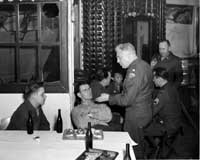
3. Lt Col White, 1949 (53 KB)
|
|
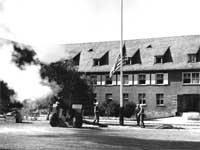
4. Retreat
(108 KB)
|
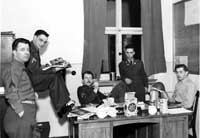
5. Christmas
1949 (44 KB)
|
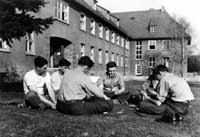
6. Card
game in front of #37 (97 KB)
|
|
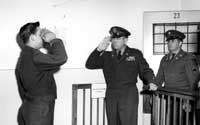
7. Inspection (52 KB) |
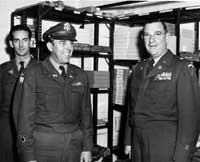
8. Inspection
(67 KB)
|
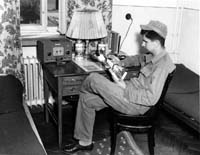
9. Severin
relaxing in his barracks room (53 KB)
|
|
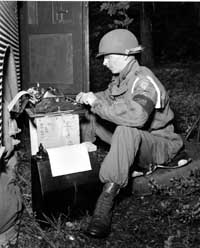
10. Cpl Wallace L. Paulson, 7796 (87 KB) |
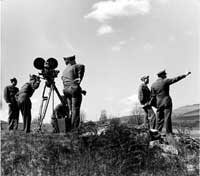
11. Motion Picture Section (79 KB) |
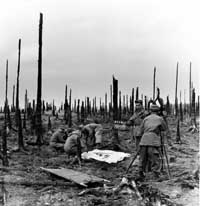
12. American Graves Registration team recovering WWII remains
(91 KB) |
|
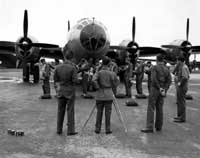
13. B-29 Superfortress (98 KB) |
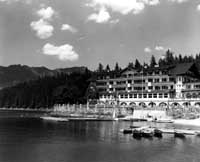
14. Hotel
Eibsee (110 KB) |
|
|
|
| |
| (Source: Email
from Werner J. Severin, 7796 Sig Co, 1948-50; Paris and Orleans, France,
1950-52) |
I was in the
7796 Signal Photo Company at Hanau Signal Depot, Germany from the
last week of December 1948 until November 1950, when Sgt. Vincent
Jermolowitz and I (a Cpl. at the time) were transferred to Paris to
set up a photo lab. Eisenhower arrived a few weeks later to set up
SHAPE Headquarters.
Served in Paris and Orleans in Signal Photo until March 1952, when
I returned to the States to the Signal Corps Photo Center, Long Island
City, Astoria, Queens, New York. Discharged as a S/Sgt. from Fort
Jay on Governors Island on June 14, 1952. |
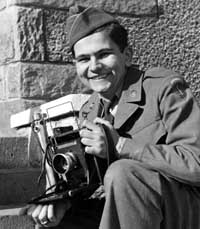
Werner Severin
|
|
While
at Hanau I was flown to Berlin in April 1949 to cover the lifting
of the blockade, back again for the May Day 1950 attempt by
the FDJ (East German communist youth) to storm the city, photographed
Charles Lindbergh with the CINC of USAF-Europe (which made both
Time and Newsweek), shot a series of pictures around Germany
of Armed Forces Radio stations and personnel, etc. Also spent
several days in Bastogne, Belgium to photograph the dedication
of the large war memorial to Americans who died in the Battle
of the Bulge and made photos of General Anthony McAuliffe, who
commanded the 101 in Bastogne at the time of the battle. One
of them of McAliff on the town square is reproduced in a book
about the battle.
In France I covered Ike's return to Europe and his return to
Normandy, June 6, 1951 (which resulted in an international prizewinning
color photo). During summer 1951 I drew an assignment to fly
from Orleans with a captain in an L-5 to make low level photos
of possible sites for American military bases.
In February 1952 I took a three men and a jeep and weapons carrier
(3/4 ton truck) and went to set up a photo detachment in Verdun.
Returned to Orleans and went to Bremerhaven to rotate home after
39 month in Europe. |
|
I can contribute
to the 7796 history in Hanau during the time before Bill Doyle arrived
in the company (after I left for Paris).
BTW - "Ed" Goss (actually Emerson Garrett Goss) was a close friend
of mine in Hanau. He invited me to join him on a weekend trip to Bad
Orb where he had been a POW. We stayed with the Roeder family, where
he had been housed after an appendectomy by U.S. Army doctors after
he was liberated. We went up the hill and visited the POW camp. My
son has an oversized book of WWII pictures which includes a double-page
picture of the liberation of the Bad Orb POW camp.
Werner Severin |
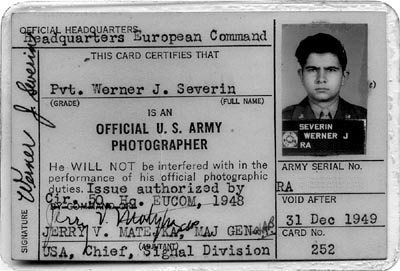
|
Official
U.S. Army Photographer ID card. Information on IDs is self explanatory.
|
| |
|
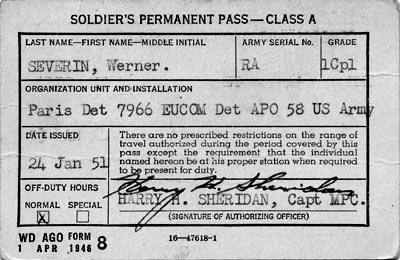
|
We
carried Class A Permanent Passes, ate in the SHAPE enlisted
mess and had U.S. Embassy Restaurant privileges. |
|
| |
| (Email: Bill
Doyle, 7796 Sig Co, 1950-52) |
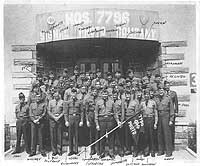 |
|
7796
Signal Company (Photo),
Hanau Signal Depot.
I was assigned to 7796th Signal Photo early 50 to early
52. The photo at left was taken around 1951 as the company
got a few draftees in. |
|
|
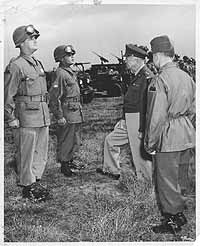
1.
Gen Eisenhower, SACEUR, talks to men of the 2nd Armd Div at
Camp Y-79 (KB)
|
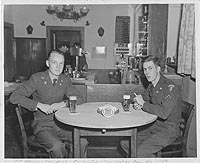
2. Two
soldiers relax with a cold 'bier' at the Fischerstube (KB)
|
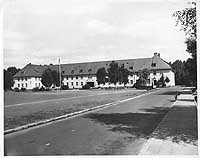
3. Bldg 37 - 7796 Sig Photo Co (86 KB)
|
|
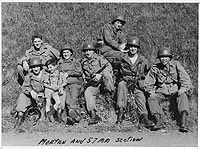
4. Members
of L Company, 12th Inf (KB)
|
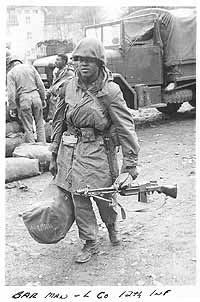
5. Soldier
wirh BAR and duffel bag, L Co (KB)
|
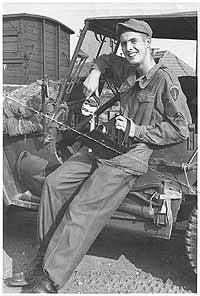
6. Bill
Doyle in Landshut (KB)
|
|
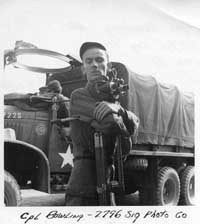
7. CPL Bowling in Landshut, 1951 (57 KB) |
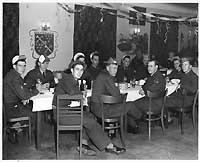
8. Holloween
1951 (111 KB)
|
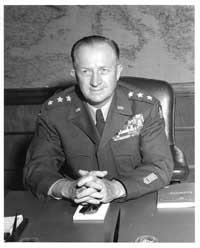
9. Gen
Eddy, CG 7th Army (100 KB)
|
|
|
|
| |
Bill Doyle's
Personal Recollections
Walked into the post office in May 1949 and got to talking to Sgt
Buck, the recruiter. At the depot in Detroit I was offered the change
to go Air Force. Turned it down - might as well go all the way. Bad
move.
Next thing I knew was on my way to Fort Riley or to be exact, Camp
Funston, where I was assigned to "H" Company, 87th Regiment, 10th
Infantry. Completed 12 or 14 weeks basic and then on the Fort Monmouth
for Still Photographers School. Had my choice of almost any school
that but the one I wanted was Bomb Disposal. Had to be 21 and I was
only 17. Only proves that someone takes care of damn fools.
Signed up to go to Japan but got an assignment to the 7796th
Signal Photo Company in Hanau. I think it was January of
1950 that I headed for Fort Dix for processing out. We went by train
up to Brooklyn Army Port and boarded MSTS General Rose heading
for Bremerhaven via Southhampton. |
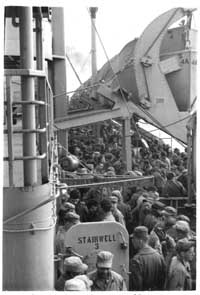
Luxury cruise
|
|
Must
have been 2000 or more troops on board and about 50 or 100 dependents.
We joked about the space allocated. It looked like 50% for us
and 50% for them. Don't know about how they ship troops these
days but then it was canvas bunks and four or five high, salt
water showers (cold as I recall it but I may be wrong) with
sea water running down troughs on the ships side for the toilets.
Common trick was to send burning toilet paper down the line.
Not good on the backsides.
I got a top bunk which meant that that you had to be very careful
when getting out as the ceiling (overhead) was hard and not
much more that 24 or 30 inches above the bunk. It did have the
advantage that nobody was above you. You didn't get splashed
when some soldier heaved his guts up. Luckily I had a cast iron
gut but many didn't.
The North Atlantic is no picnic in winter and we ran into a
gale or two. The 50 gallon drums which were in the compartment
as trash cans soon filled up with more than trash. The sea sick
ones who couldn't make it to the deck or heads got rid of their
stomach contents made a quick stop before heading on.
Meals were almost on a continuous basis as it seemed that you
spent a lot of time wending your way through the ship heading
for the messhall. Can't remember much about the food but I'm
sure that it wasn't gormet stuff. Especially when the guy next
to you would get a whiff of the food and it would trigger off
his sea sickness again. I got the feeling that some of the food
must have been left over from WW2. |
|
There was a ships
newspaper put out by the Chaplain's Office which gave out how far
we had travelled and some world news. The older troops (in terms of
service) quickly volunteered for duty working there or other soft
jobs. That way they could avoid some of the other stuff like guard
duty. Making sure that the troops stayed away from the officers and
dependents quarters on the upper decks.
My compartment was on a lower deck and the only thing lower than us
was a cargo deck. The only thing forward of us was the brig and the
heads. I was lucky as I was the runner for the MSgt in charge of the
compartment. He had been the Mess Sergeant while I was at Signal School
so he set me up for the trip. I never was keen on KP. |
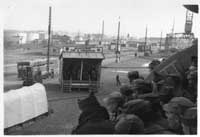
Bremerhaven POE |
|
We also had movies in one of the compartments which was set
up as a day room or recreation area. As I recall it that compartment
had no furniture in it. Everyone sat on the polished floor and
slid back and fourth as the ship rolled from side to side. There
was also a small ship store selling tooth paste, cigarettes
and cigars, as well as boxes of candy bars. 24 Hershey bars
at a time no singles.
Of course there were the long drawn out card games, endless
bull sessions as well as getting out at night to see the illusion
of the stars (when it was clear) rolling back and forth in the
sky. The trip seemed like a long time but I don't remember how
long it was before we hit Southhampton as we made very slow
progress. Vaguely I remember something about losing a propellor
but can't remember anything for sure about this. It may have
been another ship or just one of the rumors bouncing around.
To get to Southhampton you travel up past the Isle of Wight.
For a change England had clear skies and a warm sun. It was
beautiful and green with large estate houses and lawns sloping
down to the estuary. It was certainly not where the poor people
lived or at least we could not see them. |
|
| We stayed in
port for almost two days while cargo was unloaded and some troops
got off as they were assigned to units in the UK. The rest of us had
to stay on board. They weren't about to let us off. The docks had
been heavily bombed and it looked pretty drab after the Isle of Wight.
We were amazed at the dockers who came aboard to handle cargo. They
were wearing coats and ties. Not too clean and and well worn. They
got a bit of a ragging from some of the troops but they took it in
good spirit. Probably used to it. Once in a while a woman would be
on dockside and the ship would develope a list as everyone strained
get a look or do some flirting. |
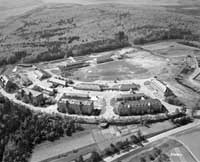
Tannenberg Kaserne |
|
We
left Southampton at dusk. There wasn't much to see as we left
but as soon as we left the estuary and headed for the channel
all the watertight doors were closed and we couldn't get from
compartment to compartment. We could up on deck and back down
again but the forward part of the ship was darkened and it was
difficult to get around. The watertight doors were supposedly
close because of leftover mines but could have been a routine
for the channel due to collision possibilities.
We arrived in Bremerhaven which had been knocked about quite
a bit and the railway yards still had bombed out locomotives
and other wreckage from allied bombing. It is hard to be specific
after more than 50 years but I think we were loaded into freight
cars at dockside and then down to troop trains traversed the
British Zone to Tannenberg Kaserne in Marburg. At Marburg for
processing. This consisted of briefings on the country, warnings
about VD, scams and other information. We got our EUCOM I.D.
cards which were on local issue. Wasn't much to it - just a
picture and some information on a card. It would be interesting
if someone had a copy of one of them. We also had to had to
change our unit patches to our assigned units. Not much variety
there as I only recall the Big Red One (First Infantry Division),
U.S. Constabulary (Circle C Cowboys) and the EUCOM Patch (Flaming
Butter Knife). It was later called the SHAPE patch but I don't
think SHAPE had been established yet. |
Could add that
they had a band playing at Brooklyn Army Port. Ended up playing
"So long - It's been good to know you" and upon arrival at Bremerhaven
the band there played "I wonder who's kissing her now?". Also, it
must have been the Rose that lost the propeller as it had
two screws.
Being a young trooper I couldn't wait to get to town. Another trooper
who was a bit older than me went with me to town to sell some cigarettes.
He had been in country for a while so he knew the score. Got offered
every useless notes in German history but finally got a decent price.
Drank a lot of beer, landed up in a DP camp with a bunch of Ukranians,
and lost my virginity.
|
| |
7796th
Signal Photo Company
There were only two of us assigned to the 7796th so we travelled from
Marburg to Hanau via Frankfurt. Corporal Schwartz who was an ex-marine
was in charge so I had someone who had some idea of what we were doing.
On many of the main line trains there was a car designated solely
for the occupation forces along with a can of potable water at each
end of the car. It was usually half empty while the German sections
were fairly full. When we got to Hanau we called for transport and
someone picked us up in a 3/4 ton weapons carrier. Corporal Schwartz
in the front and me with the bags in the back. It was a short trip
to Hanau Signal Depot where I was to start duty as a still photographer. |
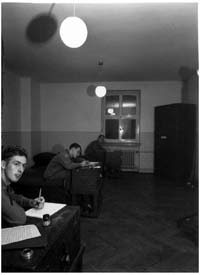
7796th billets |
|
The
first thing that impressed me on arrival at the company was
that accomodation. After Camp Funston and Fort Monmouth barracks
built for WW2 with open bays, rather primitive shower and toilet
(by todays standards) facilities it was surprising to see the
standards in for the ex-Luftwaffe base. Since I was only a private
E-2 I got to share a room with only two other troopers. We even
had a desk and chair, footlockers with stands as well as large
wooden wall lockers. A far cry from the hanging racks behind
your bed.
Even though we were a service unit we had the usual field gear
and weapons. At this time no civilian clothes were authorized
to wear in Germany. Later on when I went on leave to Switzerland
I wore civilian clothes for the first time in about 18 months.
Felt very loose after tailored uniforms.
One of the perks of the unit was our own tailor shop and the
first thing that had to be done was to put correct patches on
all our uniforms as I only had sewn one on my "Ike" jacket.
Secondly we had the jackets cut down to form fitting. Don't
remember if there was a charge for this but if there was one
it was pretty small. Dry cleaning was through the PX and as
I recall it we had some sort of laundry service within the Hanau
area. We also had cleaners who took care of those little things
like making the bed, changing the sheets, and cleaning up the
rooms and other areas. I think that we paid for some of this
through a company slush fund collected by the First Sergeant.
Although "slush" funds were not exactly legal it was usually
beneficial for the troops if the First Shirt was honest. Ours
were. Other amenities may have been paid for by the Army. i.e.
we probably paid for the room service but the army probably
hired German workers as cleaners and laborers for other functions.
All in all it was a pretty lazy life after basic and signal
school. |
|
| Base facilities
were excellent. We had a movie theater which changed movies around
three times a week and cost 25 cents for first line movies. There
was a small PX with the basics, a small snack bar and an NCO/EM club
as well as a service club. The service club was staffed by service
club hostesses (middle aged? - at 18 anyone over 30 was middle aged).
The club served liquor as well as some snacks. Beer was somewhere
between 10 and 20 cents a bottle and I think mixed drinks were 20
or 25 cents. A large bowl of french fries was 25 cents. The service
club offered games, coffee tea and donuts and a comfortable place
to sit. It was a place where you went when you were too broke to go
anywhere else. The Hanau complex had quite a few Kasernes in the area
and the Hanau Engineer Depot was the main center as they had the biggest
club, PX, and other facilities in the area. They also had the off
duty education center there. There were base buses with German Drivers
connecting all these units as well as buses which ran into the Hauptbahnhof
in Frankfurt. |
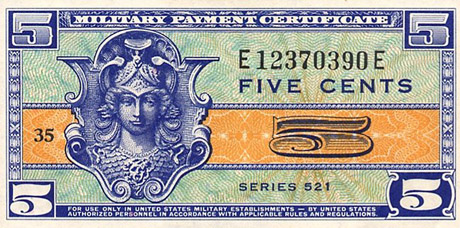
Military Payment Certificate - "Scrip" |
|
At
that time the U.S. dollar was officially pegged at 4 marks,
20 Pfennigs. However you could get more on the black market.
I don't know when our forces switched to greenback dollars in
Germany but then we had to make do with military scrip otherwise
known as "Mickey Mouse Money" which came in 5,10, 25 cent and
1, 5 and 10 dollar notes. MPC notes had a slight premium of
maybe 5 marks to the dollar while real green may have got up
to 6 marks especially if notes were in large denominations.
There was also the black market for cigarettes, pipe tobacco,
coffee and other items which sold well. A carton of cigarettes
would cost 1 or 2 dollars and could get up to 20 or 30 marks
for it. The price would fluctuate dependent on distance to payday
and whether the Air Force had flown in. I think that the large
scale black marketing had died down after the airlift and when
the Deutschmark had been pegged at 4.20. |
|
| In 1950 lower
ranks had to have six months in the Zone before a permanent pass was
issued. Higher ranks had passes where they could stay out overnight
seven days a week. They just had to show up for reveille Given that
German men over 18 had taken heavy losses during the war there was
a surplus of women so it was not too difficult some of the older men
to obtain a partner. Only a few people had cars in those day as there
was not too much money floating around but some managed. A surplus
jeep sold for about $300 dollars and if you reenlisted for six years
you got a $360 bonus. With my luck permanent passes went out the window
as soon as the Korean war broke out. I was short of a couple of weeks.
We got the occasional 24 or 72 hour pass but for the younger low rankers
it was usually a case of heading back to the base on the last bus
from Frankfurt which left the RTO about 1030. Later than that you
had to take a train out to Hanau and pay for a taxi. The RTO had a
small snack bar and PX that sold magazines during the day. When the
magazine stand was closed up for the night there was always a few
soldiers sleeping it off on the stand. |
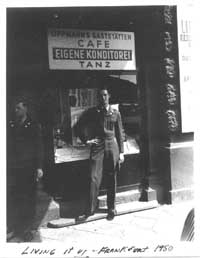
Lippmann's |
|
Across
from the Hauptbahnhof was Schuman's Cafe which had a bigger
snack bar and a PX on the first floor. Very convenient as you
could buy stuff there and walk around the corner to sell it.
Downtown Frankfurt had quite a few military facilities. The
Baseler Hof hotel which housed transient families, a movie theater
and another hotel just down the road as well. There was another
center called "WAC Circle" which was still going around 1965/66.
While these places were convenient it was the gasthaus, bars,
clubs, and women that provided the draw to Frankfurt. There
were plenty of troops in the city itself but the catchment area
for nightlife included Rhein Main, Hanau, Wiesbaden and other
places. Popular watering holes were Lippman's Cafe where they
had dancing on the second floor and amateur, semi-pro or professional
girls hung out, the Trocadero with telephones on every table,
and of course Meyer Gustl's with the ompah ompah bands. The
"Troc" was popular since you could inspect and sound out the
girls before making any committment. I think that some of these
girls had to have medical inspections and carry i.d. cards which
identified them as working girls. The Polizei made frequent
inspections of these clubs and the MP's also made their rounds.
Providing that you could see a couple of cartons of cigarettes
a man could have a Saturday and Sunday out for little cost.
Lippmans Cafe in Frankfurt which was about two blocks southeast
of the Hbf. Must have been early 50 as still wearing upper and
lower sets of brass. Later it was reduced to U.S. and branch
insignia. Note tailored jacket and trousers. |
|
Now that we have
the AIDS virus it seems that other STD's like syphilis and gonnorrhoea
are pretty minor problems but the army took it pretty seriously at
the time. If you reported it to the medics, it was "line of duty"
so it could pay to see the medics before you got caught on a "short
arm inspection."
We also had lectures on Character guidance, citizenship, and morals.
The last part was given by Chaplains who were trying to prevent us
from acting like the licentious soldiers that most of us were. It
didn't work. More practical measure in photo company was the issue
to 3 condoms with your pass. These (three for ten cents) were bought
out of welfare funds and a prophylactic kit containing a soaped rag
for washing, a tube of medication (probably a sulfa drug). A do it
yourself job. If I can recall correctly there was a "pro station"
right near the Hauptbahnhof complete with blue light. Never used it
myself. I'm not sure if we had a special toilet for VD cases in the
7796th because no one ever caught VD. When I was in the 12th Infantry
I do remember one toilet being reserved for use by those being treated
for VD. I knew one Sergeant who had caught syphilis in Africa in 1945
and he was still being screened every six months. Photo company was
not full of troops who could be called paragons of virtue. My previous
sentence about the lack of VD should have read "officially caught
VD". Syphilis was relatively rare as compared to the "Clap" so if
one of the troops started dripping he went down to the First Sergeant
if he was short of money and borrowed five dollars from the slush
fund. He also obtained got the address of a discrete German doctor
in Frankfurt. He did a screen for genococcus and if positive gave
you a shot of penicillin which usually did the trick. Nothing went
into your medical records which were not very private in those days.
It was also known for a soldier to borrow the five dollars to see
the doctor with no evidence of any VD. If you asked the First Shirt
for 5$ because you wanted to go to town you would probably get knocked
back.
Researching for these personal recollections dredges up more and more
memories. Not always in chronological order. Reading the section on
Frankfurt reminded me of the Number 39 streetcar which was reserved
for military personnel and made the rounds of the kasernes and the
Hauptbahnhof. Pretty roudy late at night but the last bus to Hanau
Signal Depot could be a bit rough and ready as the troops had been
partying. Another one of the perks of the occupation was not paying
on streetcars. We also could buy rail tickets through the RTO at cut
prices. I could make it down to the Swiss border for about a dollar
travelling in a first class compartment. After that it was back to
normal civilian prices. Don't know about other directions as most
of my other train travel was by military rail warrant. However when
public transportation was not available hitchhiking was always a possibility
as there always military traffic on the road most the time. On the
other hand it was not unknow for a G.I. to give a lift to a female
standing besides the road. They got in at their peril.
The 7796th didn't seem to go back much further than the airlift. I
can't find anything about it previous to that time on the net. It
did not last much further than 52 or 53. I have no idea why it expired
or how the same functions were taken up by other unit. Possibly they
evolved from other signal units and were absorbed by other signal
units. In 1951 I was reassigned to a photo detachment and I think
we were under the umbrella of 17th Signal in Karlsrue. If anyone knows
any more of the history I would appreciate more information.
In 1950 all the personnel were regulars as there was no draft at the
time. I think that the draft ended around 1948 and started again in
July or August of that year. I don't think the officers had regular
commission but I'm not sure of that. When I arrived in the unit there
were four officers and about 50 enlisted me. Shortly after my arrival
I believe that Captain Kennth M. Mears took over command from a Captain
or Major West. Lieutenant Williams was his executive officer. Lt Marley
and CWO Lashe were at the film library in Friedberg. The First Sergeant
was SFC or MSgt Mahoney.
It was pretty much of a self contained unit with our own cooks, motor
maintenance men, supply men, U.S. and German civilians as well as
still photographers, motion picture photographers, sound men and laboratory
specialists. The film library in Friedberg took care of all the training
and historical films for EUCOM. I was lucky to get assigned to this
unit as I could more or less do straight photography rather than spending
time in the lab or doing paperwork associated with the pictures. Of
course the other specialists like motion picture men had no other
place of assignment other than the 7796th. Still men could be assigned
anywhere and would have to be jack of all trades as they may be the
only photographer on a post. The motion picture men shot with 35mm
single lens or spider (3 lenses) eymo's. I think that their film was
processed at company level and then sent back to the states for editing
and/or including in the army's public relations or training films.
One of the locally filmed items was that of the EUCOM (7777th) Honor
Guard at Heidelberg. A company of black Americans who performed a
silent drill at the quick step. That was a major segment of one of
the news films we saw. This was probably one of the last units desegregated.
The 7796th was an all white unit until 1951 when a black American
was assigned as Motor Sergeant.
By today's standards our equipment was pretty primitive. We were issued
4x5 Speed Graphic press cameras because the large negative could be
enlarged much better than the 35mm used today. Used to fight for the
black and white film call Super Pan Press as it had a speed of around
120. Flash bulbs came in two sizes with the larger one being the size
of a light bulb. It was in 1950 or '51 when I saw my first strobe
light. Not only was it unreliable but the battery pack weighed a couple
of pounds. Color film which was used rarely had a speed of around
12. Compare that with color today when amateurs have regular access
in the supermarket to film with a speed of 400 and it can be developed
and printed locally. Lab techniques have also changed with the advent
of the computer and digital cameras. As for motion pictures it may
only be movie studios that use film these days. Later on after the
start of the Korean War we got a few officers who were recalled reservists
from WW2. One officer was pretty critical of our efforts from some
of our material seen in the states. He was determined to whip us into
shape. He cooled down after he saw some of our equipment and the conditions
(photographic) we had to work in. |
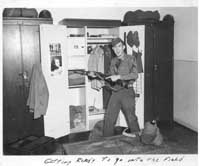
Barracks |
|
The
unit had more than our fair share of vehicles. At one time we
had more vehicles than we had drivers. We had 4x4 Jeeps, 3/4
ton weapons carriers, a deuce and a half or two, a couple of
tractor and trailers. As well we had a 3/4 ton ambulance which
had been converted into a motion picture truck. It had a platform
built on top to give the motion picture men a bit of height
for some of their shots. It also had racks inside to store equipment.
More importantly it had a mattress in the back for amorous adventures
if you got lucky. If not, one man could grab a bit of sleep,
while the other drove. It was not unknown for some of the crew
drinking beer on the platform while driving through some of
the back roads. One of the trailers as I recall it was a mobile
photography lab. I wasn't in the company more than a week when
I was asked about my driving skills. Had a few lessons (about
two hours) from one of my uncles, had driven for a couple of
hours in the city and a few hours in the mountains in Colorado.
There were a couple of us sent to the motor pool for testing.
A Warrant Officer told me to get into the cab of 6x6 and said
"get it down the runway and back without stalling it or rolling
it and you've got your license". I could manage that an a couple
of hours later I was sent to Heidelberg with a load of transformers
or something. The traffic was not that heavy in those days and
I could say that I learned to drive somewhere between Hanau
and EUCOM headquarters. I liked to drive and see the country
so I did a lot of the courier runs around the zone. One of the
better runs was down to Heidelberg as on the autobahn there
were snack bars for the passing military traffic. In winter
with a canvas covered jeep it was always a relief to stop at
the Darmstadt snack bar for a cup of coffee and some donuts.
That would be about 15/25 cents in those days. Another pleasure
for me was stopping to eat at a trucking battalion somewhere
between Darmstadt and Heidelberg. I mentioned before that I
got a soft job on the ship over as the compartment commander
was my Mess Sergeant from Fort Monmouth. I forgot to mention
that he was an (Afro American) or whatever it politically correct
to say these days. He was a real gentleman in my book and a
good friend. Anyway when I stopped to see him, and the cooks
knew I was a friend of his, I was treated like a king. The messhall
down the road is always better but he ran an outstanding facility.
My jeep also had problems passing Rhein Main Air Base. When
the AF was bitching about the food us Army types were asking
for seconds. . |
|
| In 1950 the unit
was composed of regular army, some career types, some left over from
WW2 and a good many who signed up to see the world, learn a trade,
or were economic refugees who couldn't get a job on the outside. I
was a bit of all three; especially the latter as I was trained as
a printer but being under 18 couldn't work at such a dangerous trade.
Contrary to popular myth the regular army was not a haven for the
unemployable. There were some very talented people in that outfit.
I was not one of them as I was a hack photographer. I could always
get the picture but artistic composition and print manipulation was
beyond me. There were a lot of characters in the unit. Cpl Jesse an
ex-paratrooper who chased a German railway train off the signal depot
and who would try anything. Bill Tynan from Los Angeles who always
had a joke on hand and was a dab hand at writing letters to the editor
with scathing criticisms. |
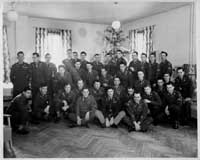
Christmas Party |
|
This picture was taken in December 1950 prior our Christmas
party in the Dayroom. The Corporal on the lower right and having
a cigarette in his hand was injured in a motor accident coming
back from Frankfurt that night and died in the 97th General
Hospital in Frankfurt shortly there after. Eight of the people
in this picture were WW2 veterans. All were Regular Army as
there was no draft then. |
|
|
Ed
Goss who was captured by the Germans in the Battle of the Bulge
and had a wicked understated sense of humor. I remember him telling
me about him bravely throwing a grenade threw a window and he missed.
He had to run when it bounced back on him. He also had the choice
of freezing to death or surrendering when he was cornered. He was
a real gentleman. There was one fellow who had genital warts (name
withheld) and we thought that it was a real joke that he had a built
in french tickler. Sounds cruel but we did not know any better and
it was relatively rare in those day. Sgt Mahoney was the First Sergent
and he was a mixture. He could raise hell with you when you screwed
up or drink a beer with you. There was Mosby the typical southern
gentlemen straight out of "Gone with the Wind" Bowling was much
the same. There was a fair proportion of people who were of the
Jewish religion looking back on some of the names but so far as
I know it never was an issue. If anything it was a "so what" issue.
Because it was a technical unit better family attitudes to education
may have had something to do with this.They don't get much of a
mention in the next section as they were not notorious drinkers.
We had some wild parties in those days. I remember the First Sergeant
and I going into a brewery in Hanau on a regular basis. I would
be pulling a quarter ton trailer and the brewery workers would load
it up while both of us sat in a waiting room. No hardship as it
was equipped with steins and a faucet in the wall which was tapped
into a keg of beer. The First Shirt could hold his beer better than
me so he drove back to the depot. At one stage we had our own bar
in the building. On the top floor which was actually an attic a
previous unit had build a bar and stage out of runway matting (pierced
steel planking for instant runway) Officially that area did not
exist as it was never inspected. I think that the company bar was
initiated by the Commander in an effort to keep the men out of trouble.
If they stayed in the company area they would get in less trouble
than going to the club on the depot or hitting the other fleshpots
off the base. The volunteer barman got free beer as we sold it for
10 cents and it probably only cost 3 cents when we bought it off
the brewery. They also served balony (bologna) sandwiches with mayonaise.
Some of our more sophisticated types (Jermolowitz and someone else)
were into French music and bought records in France which played
on a company owned phonograph. To this day when I hear Edith Piaf,
Charles Trenet, or Mauroce Chevalier, it reminds me of beer and
bologna sandwiches. I think that due to a combination of the bar
going broke because the volunteer bar tender got drunk too often
and gave credit or free beer. Another reason was that someone put
the heat by snitching about an illegal "Blind Pig" which was competing
with the NCO/EM club.
We had several company party's while I was in the company. The entire
company went partying including the officers but the officers, if
they were smart, left early before it got too rowdy. The big ones
were usually held off post and I remember one where girlfriends
and camp followers also attended. Another one was held at an officer's
club in Offenbach next to the river. That was pretty notable since
there was to be a floor show complete with strippers. Being a photo
company there were plenty of cameras and the show was punctuated
by the popping of many flash bulbs. The unwritten custom was that
all ranks were equal at a company party but it didn't apply the
next day. Anyway there were pictures of people helping the girls
strip and someone (I know not who) bribed two of the girls to put
on a very blue show and that's when the cameras really started grinding
away. What with sex shows available in most western cities these
days that does not sound like a big thing. Getting caught arranging
something like that in 1950 could cost an officer or NCO his career
and or get him some stockade time. About a week after the party
the word got out that the CID (Criminal Investigation Division)
got wind of the value added exhibition. There was many prints and
negatives, still and movie, that were destroyed out behind the barracks.
Nothing came of it as far as I know.
These were the days when most of the troops were single, divorced,
or couldn't bring their wives over. Captain Mears who was married
to an English woman and they had their first child while in the
unit. Having a baby born in the company was an event and I remember
that we all chipped in to buy an engraved silver cup for the baby.
Some of the Sergeants had their wives with them and they lived on
housing on the base. I think that there was a long wait for housing
and you had to be an E-4 with seven years service to be elligible.
Some of the women couldn't handle some of the perks of occupation
life. Occupation duty for some was better than they had ever experienced
before. Booze was cheap and each housing unit came with a German
maid paid for by the army or the Germans. I don't know how true
it was but some NCO's and Officers managed to have their girl friend
hired as the maid. Talk about having it both ways.
In the early 1950's there were a couple of murders when dependent
wives got rid of their husbands. They were tried by courts-martial
and I think got life sentences. On appeal, the convictions were
dismissed by the Supreme Court as the military did not have jurisdiction
nor did the Germans under the rule of the Occupiers. They could
not be tried in U.S. courts either as the crime was not committed
on U.S. soil. I think that this has been remedied under the Status
of Forces Agreements but for a while there were a lot of accompanied
docile husbands.
It was not all fun and games though. We had various duties in and
out of the company. There was Charge of Quarters in the company
being on call as duty photographer. Being a Signal Supply Depot
we also had our fair share of guard duty. I only remember being
on the front gate and at the entrance to the supply section. There
were a lot of German workers on the post and the guards were supposed
to check their i.d. when they came through. When they came out of
the supply depot we had to check their bags to ensure that they
did not have any stolen items on them. The important fellow with
the brief case was only carrying his lunch. There was one post that
I always was curious about which was manned by the Military Police.
It had a double cyclone fence about 8 foot high with barbed wire
and a red box in the center. The MP was in the center section and
the dog roamed between the fences. I was duty photographer when
a call came from the guardhouse that the O.D. was picking me up.
It was a beautiful summer day and the sun had just come up and the
MP was sound asleep with his M-3 grease gun cradled in his arms
while the dog just looked at us. The Lt wanted me to shoot a picture
for disciplinary purposes. With the two fences I could not get a
clear shot but I didn't want to anyway and I told him so. He suggested
that I climb the fence to clear the wire. I just cocked the camera
and handed it to him. I was not about to surprise a sleeping man
with a magazine of 45 caliber bullets. About this time the guard
woke so I never did find out what happened to him nor what the function
of that post was.
Our official sources of news were AFN and the Stars and Stripes.
There was also the New York Times which was printed in Paris. AFN
and the Stars and Stripes were run by the army so there was
not a lot of editorial freedom. I doubt if a reporter or photographer
would last very long in either unit if they made the army look bad.
We were also told to not shoot pictures which showed people in unsoldierly
positions for publication. e.g. hands in pockets, slovenly appearances
etc. However it was sometimes impossible to shoot Ike without a
hand in his pocket so it was usually disregarded. However here comes
the clanger. The Overseas Weekly came on the scene and the
battle was on. As I recall the OW was privately owned and made it's
money on advertising and the cost of the paper. The Army tried to
block it but eventually the Overseas Weekly had a lot of
buyers. It was a raw, rough, and ready tabloid paper and they did
not pull any punches. An unfair commander or someone who was screwing
the troops soon got unwanted publicity. It also offerred a chance
for the troops to break with the party line. I don't know how long
it lasted but created quite a stir then.
When a photographer stayed on the depot, life was pretty routine
so far as photographs were concerned. Pictures of damaged supplies,
local sports, parades, and the inevitable charity drive. Once when
they were doing a stunt about Thanksgiving the Post Commander was
holding a large, lively and nervous turkey. I caught a good shot
of Colonel, Turkey and turkey crap dribbling down the Colonel's
pinks. Had to reshoot that one. We also had the job of duty photographer
for any serious incidents that occurred during the night. I didn't
mind that job as if you worked past midnight you got the next morning
or day off. We covered traffic accidents, suicides, deaths of all
sorts. Now with all modern gear doing the thinking anyone can do
this type of work with a minimum of training. Point and press is
about all there is to it.
On an unofficial basis other units would have a company party and
want a photographer. We furnished a photographer, shot the pictures,
and processed the negatives and gave them to the unit. They could
then take them to the PX get as many prints as they want. The photograph
was always treated pretty well with drinks and food so it was a
good idea to shoot early. I remember enjoying the hospitality of
an MP company at Hanau Engineer Depot I was half full of beer when
an MP on duty drove me home about midnight. Next thing I knew was
the CQ pounding on my door telling me to get ready to go out. Dawn
was just breaking and I was not feeling too great. The same MP that
brought me home too me over to a rail line where one of the SP's
(usually Polish Guards) had been run over by a train or two. He
was scattered for a hundred yards down the track and the MP with
me got sick. Not the best time to have a hangover but I had work
to do. Things like that were more exciting than working in the lab
which I hated (probably because I was not very good at it) or captioning
or cataloging prints which I found boring. That why I was readily
available when a driver was required. Got qualified up to the company
semi and trailer.
There were some interesting assignments which gave us a lot of freedom.
J.W. Treadway and I had a 6 or 7 day trip to Italy for the opening
of the U.S. Military Cemetary at Anzio-Nettuno. We stayed at the
Excellsior Hotel on one of the main streets leading to the Vatican.
It was a pretty posh place as I think that the Aga Khan had a floor
there while we had a room. We ordered some wine and we tipped the
bellhop more than the wine cost us. We also worried about how we
were going to pay for the room but the Embassy took care of that.
With per diem we made money on that trip. We also saw our first
douche bowl but we were not sure what it was for or how to use it.
J.W. pulled a cord in the bathroom to see what it was for and all
hell broke lose. It was an emergency alarm and staff came rushing
in to make sure someone hadn't fallen in the bathtub or something.
Very embarassing. Then there was a problem with Italian soldiers.
We were only one strippers at the time but they saluted all NCO's
and to them a PFC was an NCO. We got worn out returning salutes.
The day of the opening ceremony the two of us sat in the back seat
of an embassy staff car complete with flags on the fenders. From
Rome to Anzio each crossing was manned by Carabiniere (Italian Police)
dressed in full dress complete with cockades and plumes. As we passed
by we had to return their salutes. We were really enjoying the fact
that they probably thought we were passing Generals who rated a
salute rather than two 19 year olds. We shot pictures of the opening
and afterward went to have a beer in a hotel on the beach with our
escort who was a MSgt from the embassy. Wasn't impressed with Italian
beer. Although we went down by train we had to come back by plane
for quick processing of our pictures. We had a surplus of Italian
Lira and money was not easily convertable in those days so we had
to spend it before we left. There was a bar near the AF flight at
Chiampino Airport and we tried to drink up the money. Could not
do it and catch the flight so we hopped in a cab and went to a wine
shop and spent all the money on bottles of wine. We must have had
30 or 40 bottles with us. We travelled with B4 bags then for our
clothes and other gear but had no place to put the wine. The AF
section there had a post office and APO to APO mail was either cheap
or free so we put our clothes and other gear in cardboard boxes
and mailed it back. We had two bags full of cheap wine. We travelled
in an old C-47 with bucket seats and the lot. There was also a couple
of g.i. mattresses in the back so I decided to get some sleep. Bad
idea! We hit turbulent air over the Alps and I bounced back and
forth like a ping pong ball between the mattress and the ceiling.
Arrived at Rhein Main slightly bruised but the wine was lashed down.
Arrived back at the company to warm greetings. Not for us. It was
almost the end of the month and everyone was broke. All that cheap
wine went that night.
Some of the assignments were pretty quirky. Two of us were sent
down to one of the R&R hotels in Bavaria. I think it was Lake Chiemsee
in Berchtesgaden. A day down on the train and two or three days
in the military hotel there waiting for the cows to come home. The
cows were taken across the lake in barges and sent up into the mountain
for the summer pasturage. Then in the fall they would come back
again. It was a celebrated event as the cows were decoration with
ribbons and flowers and it would have been good to record the event
even as just a tourist event. Unfortunately from a photography perspective
it was a disaster. I mentioned before that film speeds were slow
and someone had the bright idea to disable the range finder on the
camera so that we would learn to guesstimate our distances. On an
overcast and foggy day the cows came home. The light was so poor
that exposures had to be as long as 1/10th of a second which is
too long for anything moving. Given that the f. stop on that camera
was around f4.5 in poor light the lens had to be wide open. For
a close up shot of one of the decorated cows, if one focused on
a cows nose the rest would be out of focus. No depth of field. Anyway
we had some damn good food, good quarters and entertainment. Having
to pay a surcharge of 10 cents for meals was pretty good for being
waited on and even having a string orchestra playing while we ate.
Speaking of the R&R hotels photo company got a quota to send people
down to them. It was the best deal in town and I got to go once.
Two of us headed down to Garmisch to stay at the enlisted hotel.
I think that there were other hotels for officers and dependents.
Iím not sure about the rent but I think we had to pay 50 cents a
day for quarters and 10 cents per meal. No transport costs either
as we travelled on rail warrants. Being away for seven days holiday
and not even being counted against leave time made it even better.
Both of us were a bit short of money but we made do. Went for a
walk one day and bought some fancy bread and landed up struggling
up the Wanks mountain through knee deep snow. There was a fancy
restaurant up top and the tourist were treated to two G.I.s in O.D.s
pushing their way to the top complete with large camera cases. In
the hotel bar at night there were G.I.s from all different units
from Germany, Austria, and Triest. Story was that they had room
number tags you could pin all. If you got too drunk they would ensure
you were put to bed in the right room. May be just a war story as
I did not have enough money to get that plastered.
However back to photo assignments. Some were better than others.
Guys made it to Paris, Vienna, and other places but I didnít get
those assignments. Two of us went to the British Zone for a couple
of weeks working for British intelligence. Our job was to shoot
movies and stills of most of the German radio transmitters in the
zone. We were based in Hamburg and stayed at a British transient
camp where we paid 5 shillings (70 U.S. cents) a day for our keep.
They had four meals a day and in the mess beer was less than 10
cents a pint. We were doing pretty good as our per diem was $5 so
we were doing pretty good. We left Hanau but stopped in Kassel where
we stayed in a Gasthaus where I celebrated my 19th birthday. Next
day we headed up with two frauleins in the back of our 3/4 tonner
movie truck. From the armies standpoint doing that particular job
was a disaster. The Corporal was in charge as I was only a PFC so
I went along with whatever he suggested. No military controls up
there in the zone so we landed up in gasthauses most nights. The
truck took a beating as we got sideswiped by a British Lorry but
the spare tire took most of the damage as well as knocking me around
in the back. Then the Corporal backed it into a swamp covered in
ice. The truck landed up on a thirty degree angle and slowly filled
up with icey water in the rear compartment. Had to wait until morning
to be hauled out. Then on the way to Cuxhaven I fell asleep against
the door and fell out when we were going about 35mph. Went skidding
down the road and lost a lot of skin. The Corporals solution was
to pour raw cognac on the burns and then the sulfa from the wound
pack. Worked like a charm as I recovered quickly. Then while we
were in Hamburg we parked the vehicle in a guarded parking lot and
went on the town where we split up. Sometimes during the night all
my stall camera gear went missing and I was in trouble. With all
the accessories I could have been up for $500 on a statement of
charges. On $100 a month that would have been a major disaster.
Luckily it got surveyed. I still have my doubts as to why none of
the motion picture stuff was stolen. Maybe some German newspaper
man was now in possesion of a nice Speed Graphic. We also had a
great time with some great people. The Royal Welch Fusileers usually
had a sing song in the NAAFI (British PX) and there was a lot of
beer drinking.
Being in the British Zone meant that we were as free as the birds.
For a while we thought that the BAOR (British Army on the Rhine)
off limits signs were recomendations for the action. We also were
issued BZD coupons for fuel. They could be exchanged for fuel or
money at German gas stations. That 3/4 got terrible mileage as some
of it went on beer. We finished up our part and they sent another
crew up to finish the job. This time they rolled the truck and had
a few injuries. A bad luck assignment.
Another interesting assignment was shooting pictures of the bridges
over the Danube. Got sent down to Stuttgart to Hq 7th Army Engineer
where I picked up a driver and new orders. Those orders were a soldierís
dream. Read something like "PFC Doyle and Pvt. so and so are on
a classified mission and are authorized to proceed to any part of
the 7th Army for a period of so many days. When the MPs stopped
us to look at the trip ticket we just pointed out the orders and
said we were not going to put classified materiel on a trip ticket
for them to read. For part of the assignment I dropped off the driver
and went down to Garmisch to see a fellow in the photo section there.
On the way out of Augsburg I dropped an rear axle on the jeep and
thought my little sightseeing trip was over when I got to the motor
pool. I was in a hurry and while the Sgt was in charge his leading
hand was a German who did the supervision and the work. I gave him
a couple of packs of cigarettes and said that I was in a hurry.
He and a couple of workers unhooked the front universal and pulled
the entire read end out including diff wheels and tires. Got a brand
new set. It was marvellous what a couple of packs of Pell Malls
would accomplish.
We used to photograph the VIPs when they came to Germany and some
of the conferences in the I.G. Farben Building in Frankfurt. Had
to go there often on courier runs and ride those weird elevators
that ran on a loop with sets of little box continually moving up
or down. Took a bit of timing to get on and off. Rhine Main Air
Base was the main entry point for VIPs and I remember Ike coming
through as Commander of NATO. It was the middle of winter and all
the wheels jumped into staff cars with MP escorts and roared off
at high speed. I was supposed to catch up with them in EUCOM Hq
in Heidelberg. With a jeep that maxed out at around 55mph I didnít
have a hope. Gave up and relaxed in the warm snack bar on the Autobahn
at Darmstadt. This was a time when troop strength was being built
up with new divisions coming over as well as a lot of individual
replacements being brought through Marburg and later Sonthofen.
I got sent up to Marburg as cadre to help process EUCOM I.D cards
which were issued to the troops as they arrived. Believe me Marburg
was better as Cadre than as a replacement. We also met some of the
trains coming into Camp Y-79 and as I recall it Baumholder. The
28th Division came in and a lot of the photographers clustered around
Vic Damone and got pictures of his arrival. I went the other way
and shot pictures of some guy that looked totally out of it and
looking like he had slept in the baggage rack all night. I didnít
believe that all soldiers had to be glamorous and if his picture
got in his hometown paper he would probably appreciate it more than
a celebrity.
Other changes were taking place as well. There was a movement of
zone around with the French giving up some areas around the Saarland
like Kaiserslautern and Baumholder and taking over places like Marburg.
I think it was a case of shifting of zones around so that supporting
elements would be able to move behind the Rhine. Kaiserslautern
was just being opened up around 1951 and it still had French Army
elements in it. They had a smoky cafe with cheap wine, beer and
cigarettes across from the Hauptbahnhof. In the winter it was so
smokey, funky and foggy you could hardly see the bar from the front
door. Something that reminded me of WW1 estiminets. There was also
a Gasthaus called Griesedicks on Spital Allee. Wonder combination
which was referred to as Greasy Dicks on Spit Alley in the Kaisers
Latrine.
Photo Company was changing though. Sometime in 1951 we started to
get our first draftees in as well as recalled officers. Contrary
to popular opinion about the army many of these people not only
were assigned photographic duties but had civilian backgrounds in
the field. Many of the regulars had only service experience. These
new people came from places like Ansco, Kodak and from movie studies
in California and New York. They improved the skill level in the
photographic area but field skills and scrounging techniques were
still in the expertise of the regulars.
On a personal level I was also eager to jump in a jeep or grab a
ride on a tank or what have you to shoot pictures of troops in the
field. Started to think about heading for Korea where the action
was. Was getting tired of being half soldier and half technician.
Decided to transfer to the infantry, finish up my tour, and head
out to Korea via Japan. Didnít work out in the long run. Transferred
out to 3rd Battalion, 12th Regiment which was about five miles down
the road in Hanau. Went through the 4th Replacement Company in Frankfurt
while waiting for an assignment to the 12th. Was offered Staff if
I stayed with them and worked in supply. Turned it down. Another
bad move.
Got assigned to a mortar team and we did the usual training in Grafenwoehr,
Wildflecken, and on the border forward of Fulda. Since I was not
in that unit for a long time Iíll let some one else describe their
experience in a line company. On memory though was our instant integration
which took place around thre middle of 1952. The 4th ID had two
white regiments and one black regiment. 12th and the 8th were white
and the 22nd was black. As I recall it the 22nd was split into three
sections. 1/3 of the troops when to the 8th. 1/3 went to the 12th
while the rest stood pat. The 8th and the 12 sent 1/3 each of their
troops to the 22nd. I think it took only a couple of days to happen.
Again I donít remember too much friction about when it happened.
Canít remember exactly how long I was with the 12th but we did things
that all infantry units do. Weapons training, squad movement, platoon
etc.etc. up until the Generals had their turn moving regiments and
divisions around. When the orders came from above company level
the troops on the ground rarely ever heard the "whyís or reasons"
we were doing a particular thing. Spend half the night or day digging
in and setting up the weapons and fields of fire and then get the
order to fill it all in and move. Or charging down the road on trucks
or crushing gravel to get to a certain point and then sitting and
waiting for the next movement. The fog of war also applied to the
cold war.
With the Korean war going on Europe got second best in regards to
equipment from what I could see. And rightly so, as the guys who
were doing the fighting deserve the best. However I think in many
cases they were short changed as well due to a lack of commitment
to the forces. When I got back in late November 1952 it would seem
that life in the U.S. was pretty good. Unless they had someone personally
involved it was business as usual. Most of our equipment was left
over from WW2 and some of it was pretty worn out. I had a 60mm mortar
that was worn to where you could get a 20 mil change by tapping
on the right or left side of the bipod. I also think that the design
dated from 1917/1919 or somewhere around that time. Iím not sure
but I think we still had the 2.35 rocket launcher but it was being
gradually replaced. Didnít think much of the galoshes and combat
boots for cold weather use. Shoepacs would have been a lot better.
By some fluke I got to exchange my army blanket sleeping bag for
a down filled mummy bag. That was marvellous. They were in demand
and when I left the unit in November 52, another trooper gave me
$5.00 to let him know when I was going to turn it in. He had his
old bag ready for trade in when I turned it in. Donít know where
the M-47 tanks went though as the tank battalion still had M-26ís
and the recon companyís had M-24s. Circle C types still had the
M-8 armoured car with a 37mm popgun. After all these years it is
amazing to see the newest gear for the infantryman. When I got out
and went to work at the tank plant in Flint Michigan one of my first
jobs was unpacking and cleaning off the cosmolene from the 90mm
cannon. Thought Iíd never do that again.
Anyway we did the usual. Our forward positions were somewhere east
of Fulda up in the Hartz Mountains and I think near the Wasserkuppe.
It was a place call Bad something or other and I think we were basically
a screening force. Sacrificial lambs to buy time until reinforcements
could set up a line behind the Rhine. A mate of mine who was in
an armored infantry battalion is of the opinion that not many of
us would have made it back that far. I do remember setting up a
position and then falling back through other forces who held the
line until they could fall back on us. Although it was all practice
it wasnít fun and games. Iím awfully glad the crap didnít hit the
fan.
Who can forget the glories of Grafenwohrís tent city with one latrine
for the battalion. Guys lining up to go to the toilet and getting
up at 0300 to have a hot shower. Or forget the times when on a road
march and someone had to piss off the back of the deuce and a half.
Trying to heat up a can of C-ration hash and it always burnt. Chocolate
that had to be shattered with the butt of a bayonet. Getting Marvels
or Wings cigarettes instead of Luckies or Camels. Ham and Lima Beans,
Spaghetti and meatballs, Pork and Beans (pork fat only), Hamburger
and Sausage Patties, (I could hardly tell the difference without
reading the label) and other delights. The instant coffee and powdered
cream that took ages to dissolve. Or the lemonade powder that would
have made battery acid taste good. Personally I enjoyed the compressed
cereal bar with powered milk and sugar. You were supposed to add
water to make some kind of mush out of it. I always had a lot of
them to eat dry as no one else wanted them. A forerunner of the
Muesli Bar which is probably part of todays rations.
Remember the dubious joy of walking into the woods, rifle slung,
fully armed with your entrenching tool to dig a cat hole, to have
a quick squat while a blizzard was howling between your legs. The
other happiness to be able to use a German outhouse even though
it was freezing. Ultimate joy was getting into a heated room with
a flush toilet but that never happened in the field.
Do you remember? Trading C-rations with a German farmer for some
eggs, bacon, or potatoes and both of you thinking that you got a
good deal. Or trading cigarettes for hard cider out of the cellar.
Raiding the orchards for fruit or scrounging the wood in the forest
for fires or construction. Sending the German teenagers who came
to your position down to the town to bring back beer. How they liked
the chocolate from C rations. Carrying "brot" and salami in your
gas mask case.
Finding shelter in a barn with the cows or in bombed out building
in the middle of winter and how it felt so good. Tying a string
to your Zippo and dipping into the gas tank of a vehicle. Syphoning
gas out to help start a fire when the wood was wet. How the smoke
always drifted into your face from the fire. How your face was burning
up from the fire and your butt was freezing. Rain dripping down
from the trees in the pine forest and its been raining for days.
The happiness when the sun came out, things dried, and you were
told you were going back to the Kaserne.
Remember? Getting back to garrison to find that youíve got a field
day for cleaning your gear and passes will be issued at 1700. The
quick shower, polishing up your brass and shoes and off to the Gasthaus
for Bifstek mit ei, kartoffel und salat, flushed down with a few
beers. Who could ever forget some of the floor shows that came through
the clubs? Ivy Benson and her all girl orchestra. I believe some
of them got married to G.I.s and she was always looking for replacements.
The Travelling Magician called the "Gully Gully" man.
Enough of the memories. Mine may not be the same of yours but Iím
sure that a lot of us have memories of this sort during those years.
Time to come to an end. I was getting anxious about going home as
I was expecting regiment up in Gelhausen to tell me that my rotation
date had been moved back but no word came from them. Hitch-hiked
up there and they told me that I should have been released two months
ago. I was on the next shipment. My buddy from 4th DivArty Aviation
Section was still over at Fliegerhorst but he had to come over to
Hutier to get home. We started pub crawling in Hanau and to hell
with bed check as the trucks were leaving the next morning. Boots
and I were in an upstairs gasthaus after curfew trying to impress
the barmaid with the MPís came to check the place out. One stairway
and no back entrance. She pushed us under the bar as it was the
only place to hide. We took our bottles with us and were busting
our guts trying not to laugh. The MP was leaning on the bar and
trying to make out with the barmaid and she was trying to get them
to shove off so she could get us out and she could go home.
The next morning we made reveille. Grabbed our duffel bags and were
loaded into a 6X6. For the younger people who are reading this I
must mention that in those days if you could not carry it you did
not keep it. I think they hauled us to the railhead at Hanau where
we caught a train to Frankfurt and then to Bremerhaven. Donít remember
whether it was a train carrying only troops or a regular train with
cars for us. Anyway we got to Bremerhaven Port of Embarkation where
we got assigned to normal barracks with only four or six to a room.
Others were not so lucky. I remember seeing some troop accomodation
in what appeared to be an aircraft or Zepplin hangar. Row on row
of double deck banks and I think that the individual was issued
a tag with something like "Section B, Row 12, Bunk 42 Upper". If
he lost the tag the CQ had a roster of who belonged where. There
was a lot of people in that room and it probably was worse than
the hostels for homeless people in big cities. There was not much
to do while we were waiting to load on the ship as I donít remember
any details. They were extremely efficient when it came to chow
time. We could step out of our barracks which was a couple of hundred
yards from the messhall and join in the line. At a walking pace
not much slower than an ordinary walk we arrived at the messhall
where it split into two lines. One right and one left. I will always
remember the sign above a large can that said "Leave your pfennigs
and marks here to support German orphans -- After all theyíre probably
yours". And they probably were!
Two occupation jokes. The first one was before my time but came
up because of the non-fraternization order. Is copulation without
conversation fraternization? The second was told to me by a British
soldier who asked me if I knew the difference between the occupation
armies. Told me that when it came to the German women the Russians
raped them, the French seduced them, the Americanís bought them
and the British married them.
This large movement of troops came about because of the draftees
coming to the end of their two years as well as some of the National
Guard being released. As a sideline there were a lot of illegitimate
children floating around which were leftovers from the war and the
occupation by various armies. Some were in that status because of
marriage restrictions placed on G.I.s. I knew one Sgt who met his
future wife before fraternization was lifted when he was with the
Big Red One just after the war. I think they had three or four kids
before they got permission to marry. That was around 1952. It seems
that she was a member of the Hitler Youth (which was pretty well
mandatory for young people in the Third Reich). Never having going
through the process at that time it must have taken a lot of paperwork
to get married in the years between 45 and 52. In 1959 I applied
to to marry an English girl and it still took three or four months
of before the paperwork was complete. Both single, no criminal records
and I was a Staff by then so it was one of the simpler cases. Gave
you time for second thoughts but in my case there were no second
thoughts and we were married for thirty nine years. I wonder if
the military still have any say as to who or when you can marry.
I donít remember the name of the ship that carried us out of Bremerhaven
but it was an all troop ship. The officers and NCOís even had cabins.
With no dependents on board movement was fairly unrestricted. My
best memory of that ship was that I did not get caught for any details
and having a few swigs of whiskey in the cabin of an NCO from my
regiment. The trip this time was shorter and we came into New York
past the Statue of Liberty on a clear morning. There were trains
alongside the dock and there were civilians waiting for their men
to get off the boat. We unloaded by compartment and it was a case
of hurry up and wait. We were supposed to walk off the gangplank
and unto the trains but that did not happen for some of the men
who had wives or family at the pier. They broke ranks and headed
for their people. The MPs tried to push them back into line which
stuffed the whole thing up. The troops on deck howling insults at
the MPís and the troop nearby were obstructing the MPs as much as
possible. Finally an officer from the Port Transport office came
up an agreed that the men could have some time with their families
and board the train at the last minute. They could join their companies
later at Camp Kilmer. Common sense prevailed and the train loaded
up without any further incidents.
Kilmer was one massed stuff up so far as I was concerned. We were
only to be their for a couple of days and were to go to discharge
centers close to our home of record or enlistment. I was scheduled
for Camp Custer at Battle Creek, Michigan. I remember going to the
mess hall and looking forward to breakfast. Into line expecting
bacon and eggs and what did we get - heated up C ration cans from
a garbage can full of hot water. The poor KP got most of them straight
back from the troops who had their fill of Cís. We were told to
turn in our bedding, pack our bags and report to such and such quadrangle.
We were also issued box lunchs which consisted of a couple of sandwiches
and an apple or orange. There was a couple of thousand of us out
in an open field in a cold November day waiting for transport that
never came. The people in charge were on the upper deck of the two
story barracks and they had a P.A. system installed. They kept telling
us that the buses were coming to take us to the trains so we couldnít
leave the area. This went on for two days before we caught buses
to the train. The first night we were just told to find a bed somewhere
but by then other troops had moved in. A lot of us ended up sleeping
on the floor. Tension was running high and as soon as the organizers
finished an announcement they would retreat off the balcony. Again
the troop were reacting and the occasional orange was thrown at
the people on the balcony. A couple of week after I had been discharged
I read that there was a riot or near riot there.
Finally got on buses to the trains. It was a civilian train and
the porters assigned seats and compartments. The porter on my car
saw my lack of stripes and put me in a compartment with a PFC and
we were living it up. We were routed through Canada and then down
into Michigan. We were assigned provisonal companies, given physicals,
attended briefings about insurance, the GI Bill and mustering out
pay. $100 on discharge and $100 for two months thereafter.
They were also asking the troops to give blood which I did. Told
the duty sergeant for the barracks that I was not feeling too good
after that (not true) and he let me hang around the barracks for
a couple of days. However as soon as he left to go home I recovered
quickly and headed for town. After all those months overseas I could
not buy a drink as I wasnít 21. Would go to town with my buddies
and have to order a coke while they drank beer. Some drank slower
than other so there was always that extra beer for the coke drinker.
The coke lasted all evening and the beer went down whenever the
waitress had her back to us. Probably drank more that way than if
they had just served me.
Discharge day came up and I was probably the only Private in my
provisional company. I had a hash mark denoting over three years
service but that was it. As out names were called out we had to
go up on stage where the officer shook our hands, thanked us for
our service, and handed out a discharge in my case. I got a lot
of flak over that as the rest of them got little certificates of
service and three or five years in the reserve. I was out completely.
To top it off it was my 21st Birthday.
A man from Detroit had picked up his car and he offerred me a lift
from Battle Creek. Headed out the gate and abused the MP standing
guard there. He took it in good stead as it probably happened every
time a bunch of discharged people came by.
When I got to Detroit I checked in the bus station and found that
I had a three or four hour wait. Still in uniform I went next door
to a bar and ordered a beer. The bartender asked for I.D. so I showed
him my DD214 with my birth date and he could see the discharge envelope
but that wasnít good enough for him. He wanted a Michigan Drivers
License so I told him where he could stick his bar and walked about
50 yards down to the next bar. Again I was asked for I.D. and showed
my discharge papers. This bartender annonced to the bar that it
was my 21st and had been discharged that day. Then he told me that
I couldnít buy a drink. They wouldnít let me. That evening was on
the house! Nice homecoming and I was feeling no pain when I got
on the bus.
This ends the recollections of Germany. The next time I was there
the peace treaty had been signed and I had switched over to the
Air Force.
|

|
|
|
| 69th Signal Photo Company |
| |
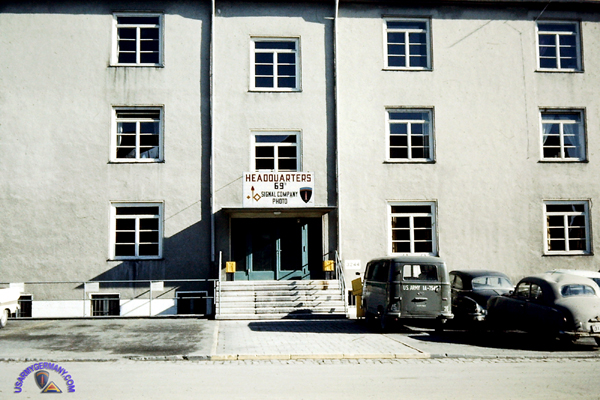
69th Signal Company barracks, Kleber Kaserne, early 1960s (Leonard Mills) |
| |
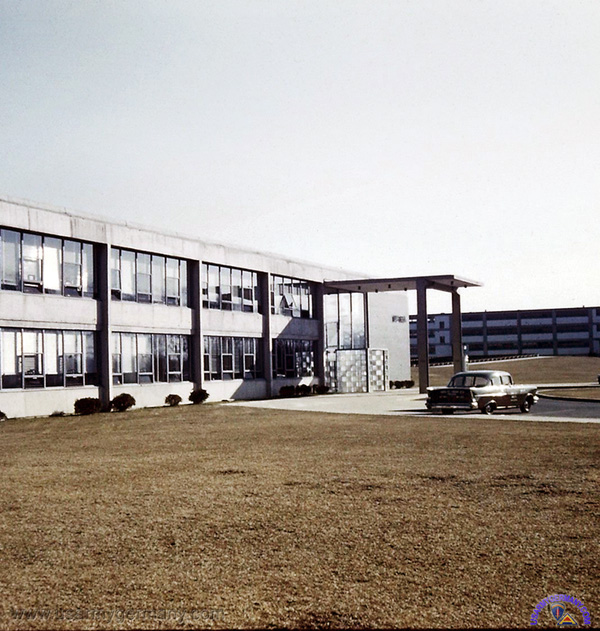
Not sure - Heidelberg Army quarters? (Leonard Mills) |
| |
| (Source: US Army Center of Military History - presenting here only information regarding service in Germany) |
Lineage: 69th Signal Company
Activated 3 September 1944 in France
Reorganized and redesignated 30 June 1945 as the 3264th Signal Photographic Service Company
Redesignated 18 June 1947 as the 69th Signal Photographic Service Company
Inactivated 20 June 1948 in Germany
Redesignated 5 January 1955 as the 69th Signal Company and allotted to the Regular Army
Activated 24 February 1955 in Germany
Inactivated 1 May 1976 in Germany |
|
| |
| (Source: Leonard Mills, 69th Sig Photo Co, 1960-62) |
| I served in the 69th Signal Co (Photo) with headquarters in Kaiserslautern and later transferred to the Heidelberg Detachment where I worked in a classified photo lab on Campbell Barracks. I believe there was a third duty station but can't remember where. My OIC at Heidelberg was Capt. Donzel Davis. (I think they liked having a higher
ranking officer as detachment commander in Heidelberg because of all the brass located at Hqs USAREUR.) NCOIC was SFC Butson and there was another NCO, SFC Nutter. Our label produced both "classified" (up to Top Secret) as well as PIO photo's. Non-classified photos were produced in a separate section of the lab as unclassified material was not allowed beyond the security gate.
I enlisted in the Army at 17 years old in Sept. 1959 (basic at Fort Ord, CA.), then spent 8 month at Fort Monmouth N.J. (at the photo lab school); then assigned to Germany, leaving from there in July of 1962 as a Sp/4. (at the ripe old age of 20).
They were great times. I still proudly wear the USAREUR rainbow/sword patch on my veterans hat. I will see my granddaughter sworn into the U.S. Navy the 25th of February.
The unit's main labs, photographers, motion picture lab etc were located in K-Town. I don't remember the name of the kaserne (Webmaster note: Kleber Kaserne). Also, the lab was within walking distance of our billets. |
| |
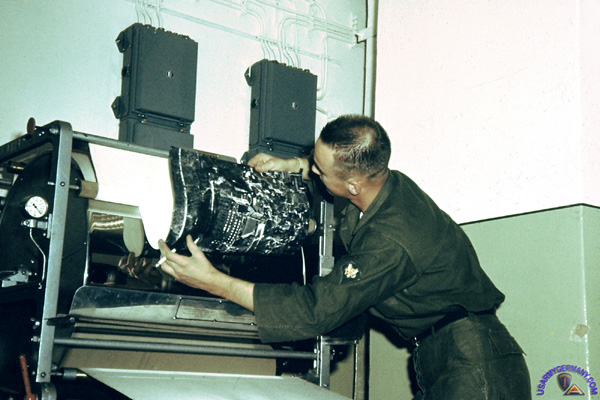
Leonard in the lab at Heidelberg, taking a print out of a dryer (Leonard Mills) |
| |
The lab in Heidelberg was originally a classified lab because of the headquarters (USAREUR). We were just a photo lab when I first got there but a PIO (Public Information Office) photographer was added in 1961. We developed PIO and classified photos in the same area until enough money came through to build a separate lab just for PIO... Wow, what a security problem. Things were much simpler then. If Top Secret stuff hit the label (most was Confidential or Secret) those not quilified had to leave until the work was completed.
All the equipment in Heidelberg was black & white. We did a little personal color slide work but nothing in color for the Army. Film sizes were 4 X 5 sheet film, 3 X 5 sheet film, 2 1/4 Sq roll film and 35mm roll film. I sent one photo of me taking a print of a dryer...that would have been in the Classified section as the PIO section did not have the ability to print and dry photos. We did have an enlarger that could handle 4 X 5 down to 35mm black & white. Some of the PIO work had to be done in the Classified section of the lab because of capabilities. That caused a bit of a problem but was handled.
The 69th also had
portable photo labs to go into the
field These were very complicated pieces of equipment that made it possible to develop and print black & white photos. Other than that, no equipment would have been truck-mounted... just the labs.
If you look at the main building from the parade grounds at Campbell Barracks, you will see small windows in the roof... that is where the lab was. I didn't realize until recently that USAREUR was moved and the facility closed. It was a great place to be stationed. I will look at my available photos and see what I have. Some inside our billet, me at work (if you want that type of stuff). Sgt Butson and Nutter I know I have.
I think the billet in Heidelberg was on Patton Barracks, a short walk from Campbell as in nice weather we usually walked to and from work. We lived with another company. There was a company of WAC's also stationed there -- at we ate in their mess hall. I remember eating in the WAC Shack and walking across a field to the Soldiers Club as well as to work and, walking just off post to a Gasthaus that was frequented by German families...not many G.I.'s went there and I don't see the buildings in my photo's or yours.
I wish I had better photos of our room in Heidelberg. We had pictures all over the walls of Paris (mine), the castle and other scenes around Germany. An I.G. inspection took longer in our quarters because they always walked around looking at the pictures etc. We were always squared away but a bit more relaxed than some. One time we had the radio on (think I sent a photo of a friend in front if it) turned down low and didn't have time to turn it off when the I.G. came through...he didn't say a thing.
Trying to think -- there were 6 in our quarters: Kay Kluz, Ed Blutrich, Carl Schultz, myself and can't remember the other two; two Sp/5's that lived off post; two NCO's Nutter and Butson as well as Capt Davis. Not a big contingent. Had a 1st Lt. assigned about a month before I left...he and I didn’t get along so it was good I was leaving.
Fun talking about this. I sure wish I had more military photos. Mine are mostly scenery, Paris, Vienna, Zermatt, etc. did a lot of traveling while there.
My primary MOS was 823, photo lab tech, but did get to fly as our photographer was frequently on other assignments and the pilot liked working with me. Great guy. I usually flew in the small two passenger Bell Helicopter, and the Beaver fixed-wing. Had one assignment that required taking photos of GSA installations from Germany to France. We used a Bell Chopper for this because where we had to go. Another assignment had the Army placing new disks on top of buildings. We used a older squad sized chopper for that and went to several installations also in Germany and France. A bracket was breaking in the chopper and we had to set down and spend the night at an Army Air Base in France. We spent the night and then flew back to Heidelberg in an unmarked Beaver.
Sure glad rank didn't bother me (around it a lot at a H.Q.) as I was with one Capt., a Lt. Col. and full bird. Most assignments were in the Bell. We were flying across the approach to Rhine Main AB when the pilot told me to keep my eye out for jets. Asking how fast the were going and how far away they were, he said they would be going around 300 knots and we were about 100k away so I said, if we see them, what are we going to do about them. He then said: nothing, don't worry about it...they will see us way before we see them. One did fly over but much higher than us. He also took off backwards after photographing a GSA site.
|
|
|
|
|
|
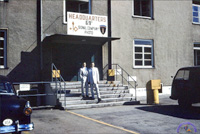
1. Entrance to Bldg 3244
|
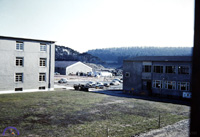
2. Mess Hall right
|
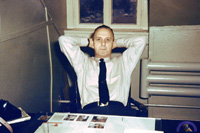
3. SFC Jack Butson
|
|
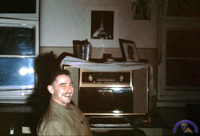
4. Quarters at Heidelberg |
|
|
|
|
|
| |
| 1972 |
| (Source: STARS & STRIPES, July 24, 1972) |
The 69th Signal Company (Photo) located at Kleber Kaserne in Kaiserslautern, is one of only two company-size photo units in the Army. The company is commanded by Capt Phillip G Patterson.
The unit has recently been transferred to STRATCOM-Europe's Signal Service Group 4.
The 69th can take and develop any kind of still photos, including aerial photographs, and can make color motion pictures with sound. |
 |
|
|
| 497th Signal Photo Company |
| |
| 1951 |
| (Source: Various US newspapers from 1951) |
| Based on information found in various U.S. newspapers from 1951, the 497th Signal Company departed the U.S. for service in Germany sometime between August and October 1951. The 497th was most likely an Army Reserve unit that was federalized in 1950. |
|
| |
| 1955 |
| (Source: STARS & STRIPES, Jan 19, 1955) |
The 497th Signal Company (Photographic) is located at Kleber Kaserne, Kaiserslautern with a detachment at Karlsruhe.
The mission of the unit in peacetime is to provide still and motion pictures in color or black and white upon the approved request of US Army, Europe. In wartime, the unit would provide photographic support to tactical commanders.
The photographers and motion picture teams assigned to the USAREUR Pictorial Center in Kaiserslautern shoot an average of 2,500 stills and 35,000 feet of motion pictures monthly covering every corner of Europe where US troops are stationed. The routine jobs include public information work and taking movie footage for training films.
The unit's USAREUR Central Film and Equipment Exchange in Karlsruhe distributes projector equipment to units throughout USAREUR through area distribution outlets such as the Western Area Command Exchange.
The six motion picture teams each consist of one officer and five enlisted men and are on the road practically all the time. In 75 percent of the cases the film that they shoot is sent to the Signal Corps Pictorial Center in Long Island City, NY, where the motion picture processing, editing and final assembly is done. The remainder is processed by the unit itself.
In addition, the 497th also maintains a four-van mobile photo laboratory that rolls out to the field with USAREUR units on maneuvers, providing on the spot photographic coverage of the field exercises. (The mobile lab consists of four vans, two 2½-ton trucks, four jeeps along with power units, pumps and other auxiliary equipment.)
Webmaster Note: a notation in the US Army STATION LIST for
15 February 1955, states that the 497th was scheduled to be released from Active Military Duty effective 24 February 1955. In effect, the 497th would be redesignated as the 69th Signal Company on that date with no change in mission or home station.) |
 |
|
| |
Related Links:
|
| |
| |
|










































